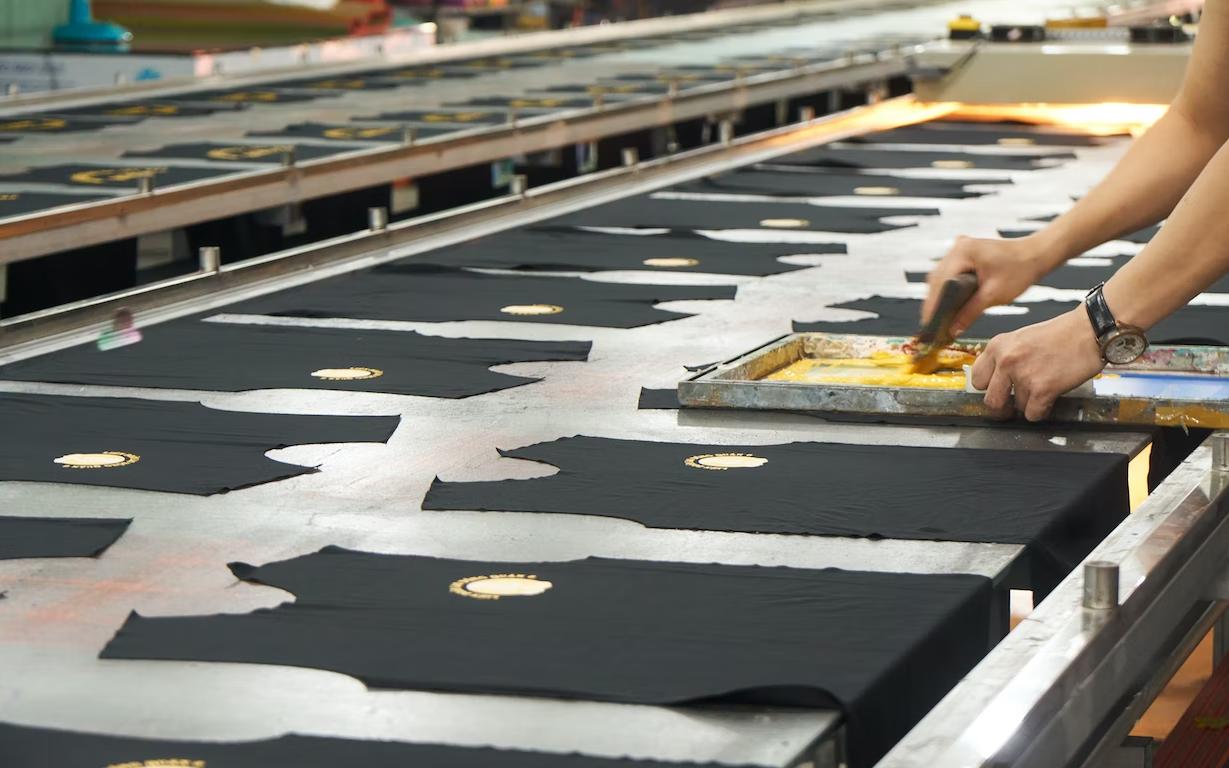Screen printing and digital printing are two of the most popular garment printing techniques used across the globe. Each of these printing techniques has a different origin and offers distinct advantages. In this screen printing vs. digital printing guide, we will examine the differences between each technique and learn which is best for different situations.
What is Screen Printing?
Screen printing is a traditional printing technique that dates back thousands of years. This practice is also known as silkscreen printing and was used to decorate apparel in many cultures.
Screen printing works by pushing different colors of ink through a special stencil or “screen”. These colors are layered on the fabric surface to achieve the desired pattern or print. The fabric and ink are then heated to help the ink set.
Traditional screen printing is done by hand, but modern technology allows this technique to be performed by machines. Cutting edge modern screen printing machinery can print up to one hundred shirts per hour.
What is Digital Printing?
Digital printing is a more modern printing process that caught on approximately two decades ago. This process creates a variety of color shades by combining six colors: green, yellow, magenta, cyan, red, and black. Digital printing machines are essentially large inkjet printers, similar to what people use in office spaces. However, they are designed to print on fabric instead of paper.
Screen Printing vs. Digital Printing: Color Vibrancy
Screen printing and digital printing are both capable of producing great looking colors on fabric. However, screen printing is able to produce more vibrant colors than digital printing can.
Screen printing typically uses Plastisol ink which is extremely opaque. This allows it to produce bright white color under bases on dark fabrics. These plastisol inks can also be mixed easily to produce thousands of color variations.
Digital printing ink generally uses water-based inks which are less opaque than Plastisol inks. These water-based inks can produce good decent underbases. However, their final results are less bright than screen printed inks.
Screen Printing vs. Digital Printing: Color Blending
Color blending is an important part of the printing process. Color blending is needed to create smooth gradients by combining different colors together to produce a smaller number of colors. The water-based ink that digital printing machines utilize is great for combining colors in this manner. This allows digital printing machines to produce beautiful gradients.
Screen printing plastisol ink can also combine colors. However, producing accurate blends is more difficult.
Screen Printing vs. Digital Printing: Details
Some people would like their custom printed t-shirts and other garments to have minute details that enhance the printed fabric’s overall appearance. Digital printing generally excels in these areas because it can capture these small details and reproduce them consistently.
Screen printing has difficulty reproducing small details so people who would like certain graphics screen printed may need to alter them to produce better results. This includes changes such as increasing text size or getting rid of tiny dots.
Screen Printing vs. Digital Printing: Durability
Durability is an important factor to consider for fabric printing. After all, everyone wants their custom printed fabrics to retain the printed image or graphic and maintain its fresh and vibrant appearance for as long as possible.
Digitally printed fabrics can be washed a dozen times before their print colors start to fade. Screen printed designs, on the other hand, can survive many more washes and look great for many years. This is one of the reasons why some printed t-shirts from the 80s or 90s still look fantastic today.
Screen Printing vs. Digital Printing: Consistency
If you intend to get many t-shirts or garments printed with the same pattern or graphic, you would generally hope there is consistency between each one. Digital printing is perfect for such jobs because it can reproduce the same image over and over again easily.
Consistency is harder to achieve with screen printing due to many variables involved in the screen printing process. This includes factors such as screen tension, ink viscosity, squeegee sharpness, dot gain, and more.
Screen Printing vs. Digital Printing: Fabric Options
Screen printing can be performed on many different types of fabric without any problems. This is due to the plastic nature of screen printing ink.
Digital printing ink works well for 100% cotton fabrics, but is less effective for blends such as 50/50 cotton polyester blends. Digital printing is also poorly suited for printing ink onto garments with fluorescent colors because these colors may bleed into the ink and discolor the print.
Screen Printing vs. Digital Printing: Special Effects
If your desired print includes many special effects such as texture, glows, shines, or even raised print, screen printing is the way to go. Digital printing can utilize some speciality inks but it generally struggles to produce great looking special effects in the way that digital printing can.
Why Choose Groggy Dog for Screen Printing?
As you can see, screen printing and digital printing are both great printing methods utilized for fabric printing. However, screen printing comes out on top in many areas. If you are interested in getting t-shirts, hoodies, pants, jackets, and more screen printed by experienced professionals, please contact Groggy Dog.
Our art team can create a great looking custom design for you and screen print it onto your desired fabrics. We understand the ins and outs of screen printing and strive to do an excellent job each time. Please visit our website to learn more about our screen printing services.


